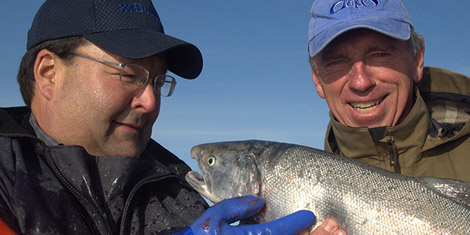Earthtalk is a regular feature that will appear every weekend.
Dear EarthTalk: What are some basic guidelines about seafood consumption, especially for women and in light of all the pollution threats to our oceans and waterways?
Between mercury poisoning, overfishing and the environmental impacts of fish farms or “aquaculture,” some might expect to see a “Proceed with Caution” sign above seafood counters soon. Others contend that fish and shellfish are an important part of a healthy diet, providing high-quality protein and omega-3 fatty acids. The U.S. Food and Drug Administration (FDA) recommends eating up to 12 ounces of fish and shellfish per week, but only if they are “lower in mercury.”
Mercury can be released into the air through industrial pollution and can accumulate in streams and oceans. The FDA warns that if you regularly eat types of fish that are high in mercury, it can accumulate in your blood stream. They add that mercury is removed from the body naturally, but it may take over a year for levels to drop significantly. For this reason, women trying to become pregnant should avoid eating high-in-mercury fish like shark, swordfish, king mackerel and tilefish, and gravitate toward low-in-mercury shrimp, canned light tuna, salmon, pollock and catfish. According to the Monterey Bay Aquarium’s “Super Green List,” fish that are low in mercury and also good sources of especially healthy “long-chain” omega-3 fatty acids include Atlantic mackerel from Canada and the U.S., freshwater Coho salmon from the U.S., wild-caught Pacific sardines and Alaskan wild-caught salmon (fresh or canned).
Of course, it’s possible to obtain long-chain omega-3s without eating fish. Ovega-3s supplement is derived from a strain of algae that naturally produces high amounts of eicosapentaenoic acid (EPA) and docosahexaenoic acid (DHA), the healthiest omega-3s. Although most people think fish are the original source of DHA and EPA, these omega-3s actually come from the algae lower in the food chain.
“When salmon farming began in North America, farmers discovered that without fish oil in their diet, farmed salmon did not contain salmon oil in their tissues,” says Udo Erasmus, Ph.D., author of Fats that Heal-Fats that Kill. “Fish get their ‘fish oil’ from the foods they eat. When we trace these supplement oils back to their origin, we find that the oils we call ‘fish oils’ are actually made by plants at the bottom of the food chain. One-celled red-brown algae makes fish oils. Fish oils are actually plant-based products.”
Algae and other plant-based omega fatty acids also will not deplete the ocean’s supply of fish. Industrial overfishing practices have wiped out certain types of fish before they’ve had a chance to repopulate, and unintentionally killed other marine species besides fish—known as “bycatch”—in their large nets. Upwards of one million sea turtles, for example, were estimated to have been killed as bycatch from 1990-2008, according to a report published in Conservation Letters in 2010. The transition to aquaculture, where fish are raised in confined quarters (like the “factory farming” of pigs, cows and chickens) has its own environmental burdens. According to the Mangrove Action Project, an estimated three million hectares of important coastal wetlands, including mangroves, have already been lost in order to make room for artificial shrimp ponds.
CONTACTS: FDA, Seafood Watch, Ovega
EarthTalk® is produced by Doug Moss and Roddy Scheer and is a registered trademark of Earth Action Network Inc. View past columns at: www.earthtalk.org. Or e-mail us your question: earthtalk@emagazine.com.





